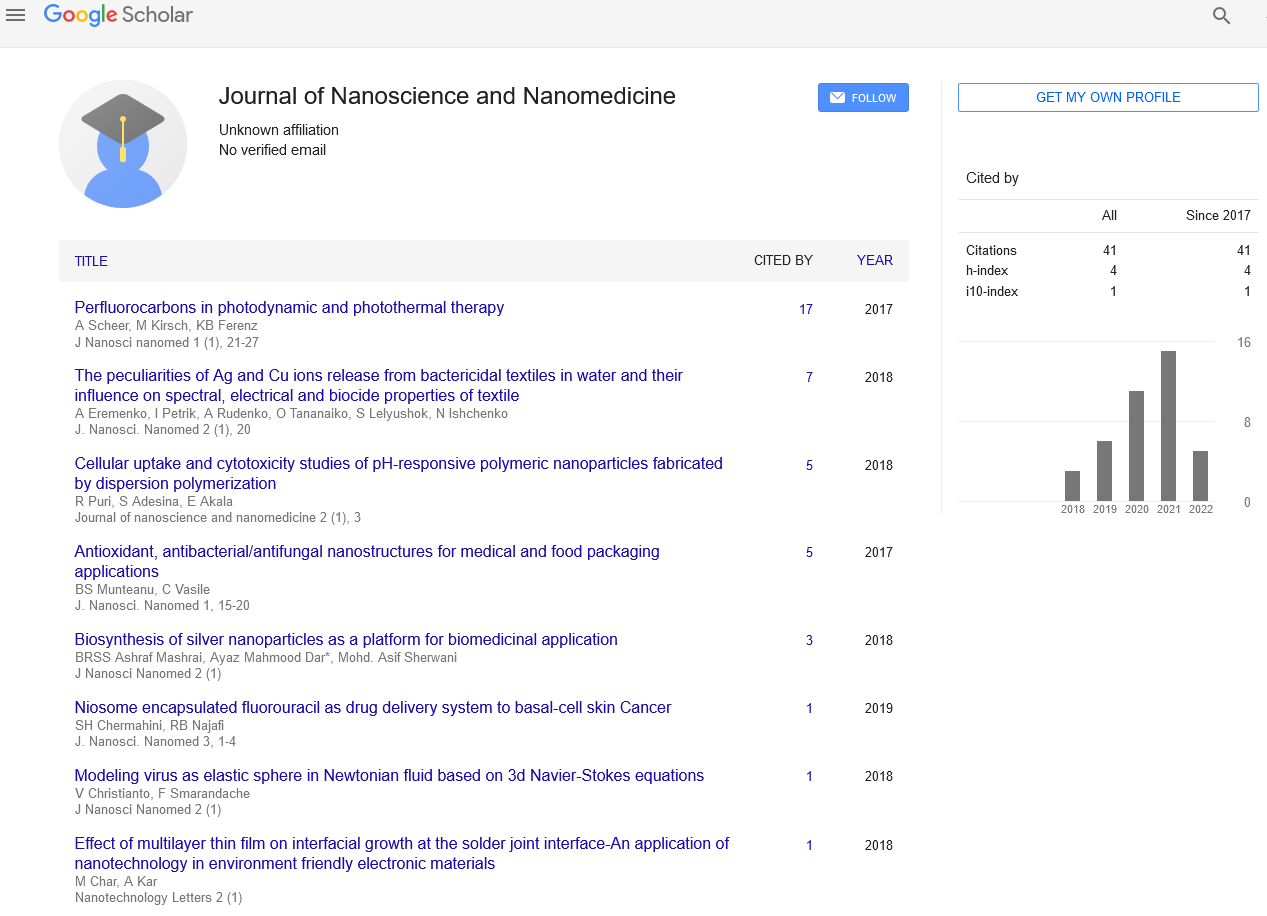A Brief note on Biogenic Metallic Nanoparticles
Received: 03-May-2021 Accepted Date: May 15, 2021; Published: 24-May-2021
Citation: Lim R. A Brief note on Biogenic Metallic Nanoparticles. J Nanosci Nanomed 2021;5(3):3.
This open-access article is distributed under the terms of the Creative Commons Attribution Non-Commercial License (CC BY-NC) (http://creativecommons.org/licenses/by-nc/4.0/), which permits reuse, distribution and reproduction of the article, provided that the original work is properly cited and the reuse is restricted to noncommercial purposes. For commercial reuse, contact reprints@pulsus.com
Abstract
Biosynthesized or biogenic metallic nanoparticles, especially silver and gold nanoparticles (AgNPs and AuNPs, separately), have been progressively utilized due for their potential benefits, including high soundness and stacking limit; additionally, these nanoparticles are integrated utilizing a green and savvy strategy.
Keywords
Biosynthesize, Nanoparticles, Silver and gold nanoparticles.Introduction
Past examinations have researched lessening or potentially settling specialists from different organic sources, including plants, microorganisms, and marine-inferred items, utilizing either a one-pot or a multistep cycle at various conditions. Likewise, broad examinations have been performed to decide the natural or pharmacological impacts of these nanoparticles, like antimicrobial, antitumor, mitigating, and cell reinforcement impacts. In the new years, chitosan, a characteristic cationic polysaccharide, has been progressively explored as a diminishing as well as balancing out specialist in the amalgamation of biogenic metallic nanoparticles with expected applications in nanomedicine. Here, we have audited the instrument of biosynthesis and expected utilizations of AgNPs and AuNPs and their chitosan-interceded nanocomposites in nanomedicine [1].
Nanotechnology is a part of innovation related with the union, portrayal, and utilization of materials in the nanoscale scope of 1–100 nm. ince at that point, nanoparticles have been utilized for different applications in science and innovation. The use of nanotechnology in wellbeing sciences is in the field of nanomedicine. The extraordinary property of nanoparticles is that they have an extensively high surface region, which works with restricting with various practical ligands. The little size of nanoparticles empowers their utilization for different applications, including advancement of new gadgets or instruments utilized in the biomedical and drug fields [2].
Biosynthesis of Metallic Nanoparticles are metallic nanoparticles are ordinarily incorporated utilizing substance techniques. Notwithstanding, the exorbitant and poisonous reagents utilized as balancing out and diminishing specialists during blend may restrict the utilizations of these nanoparticles. Also, these harmful specialists may unnecessarily gather in strong, fluid, or vaporous structures in the climate [3]. Substance and actual techniques of amalgamation of nanoparticles include the utilization of dangerous synthetic compounds and high energy; also, the cycle of sanitization of nanoparticles integrated utilizing this strategy is troublesome and inefficient. In this way, an elective strategy that is harmless to the ecosystem and including natural specialists is essential for the amalgamation of metallic nanoparticles. Additionally, metallic nanoparticles blended utilizing compound techniques have unsafe impacts when utilized for biomedical applications in light of the synthetic deposits. In this manner, advancement of financially savvy and harmless to the ecosystem techniques is earnestly expected to blend metallic nanoparticles without the utilization of any poisonous synthetic substances [4]. As of late, a green technique utilizing; normally happening diminishing specialists like polysaccharides, microorganisms (microscopic organisms and growth), or plants remove has been utilized as a basic, nontoxic, and climate amicable option in contrast to the intricate compound strategies for blend of metallic nanoparticles.
Nanoparticles incorporated utilizing this technique might be sullied by pathogenic microbes during the refinement cycle, and accordingly these nanoparticles ought to be painstakingly utilized for clinical applications. Moreover, a few examinations have shown that metallic nanoparticles, including biogenic ones can cause poisonousness, including nephrotoxicity and neurotoxicity [5].
Conclusion
Biogenic nanoparticles are incorporated utilizing natural organic entities. The justification picking natural bodies is that these living beings can undoubtedly be refined, with high intracellular metal take-up. Other than extracellular emission of chemicals it offers basic downstream preparing for item recuperation without any difficulty of biomass taking care of. The metabolic action of these microorganisms empowers the extra cell or intracellular union of nanoparticles using diverse method of union.
REFERENCES
- Li X, Robinson S.M, Gupta A et al., Functional gold nanoparticles as potent antimicrobial agents against multi-drug-resistant bacteria. ACS Nano. 2014;8(10):10682–10686.
- Sun Y, C An. Shaped gold and silver nanoparticles. Front Mater Sci. 2011;5(1):1–24.
- Dykman L, Khlebtsov N. Gold nanoparticles in biomedical applications: recent advances and perspectives. Chem Soc Rev. 2012;41(6):2256–2282.
- Corbierre M.K, Cameron N.S, Lennox R.B. Polymer-stabilized gold nanoparticles with high grafting densities. Langmuir. 2004;20(7):2867– 2873.
- Esumi K, Takei N, Yoshimura T. Antioxidant-potentiality of gold– chitosan nanocomposites. Colloid Surface B. 2003;32(2):117–123.





